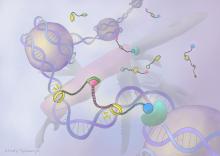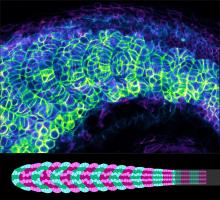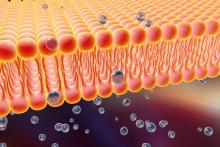Biology Cell biology
News
01 Apr 2020
A research team led by Professor Kin-ming KWAN from the School of Life Sciences at The Chinese University of Hong Kong (CUHK) has recently discovered a novel mechanism by which extrinsic signaling factors modulate the fate transition of neural progenitors to allow the generation of specific neuronal subtypes. This work provides important insight into stem cell biology and the regeneration of neuronal cells, and contributes to the development of neurological therapy for diseases like autism spectrum disorders and hereditary cerebellar ataxia. The research is published in the renowned international scientific journal Cell Reports.
26 Mar 2020
In a recent study published in Autophagy, researchers at Kanazawa University show how abnormalities in a gene called TPR can lead to pediatric brain cancer
24 Mar 2020
A new approach could lead to “cornea-on-a-chip” devices that more accurately test the effects of drugs on the human eye.
19 Mar 2020
Environmental changes trigger tiny RNA segments to modify plant pores involved in photosynthesis.
28 Feb 2020
A new compound with the potential to turn genes on and off could lead to new cancer and hereditary disease treatment strategies.
23 Dec 2019
NUS researchers found that chevron patterns in fish swimming muscles require physical forces to correctly develop, not only from genetic instruction or biochemical pathways.
06 Dec 2019
Scientists in Korea find a protein that mediates the interaction between the cellular systems involved in rapid responses against foreign genes in plants
26 Nov 2019
Researchers from the Mechanobiology Institute at the National University of Singapore have shown that cells can attach to the fibrous protein meshwork that surrounds them only if the fibres are spaced close enough. The team’s findings can explain the abnormal motility patterns displayed by cancer cells.
29 Aug 2019
A recent study, affiliated with South Korea's Ulsan National Institute of Science and Technology (UNIST) has discovered that restoring a gene altered in Down syndrome called the Down syndrome critical region 1 (DSCR1) rescued adult neurogenesis and learning and memory defects in a Down syndrome mouse model (Ts65Dn).
19 Jul 2019
Researchers in Japan have developed a new genome editing technology in rice.
20 Mar 2019
A honeycomb-shaped brace in plants keeps them fit by precisely coordinating the discarding of organs, such as flowers and leaves.
07 Nov 2018
New research documents how modifications to RNA keep nerve junctions flexible.
25 Oct 2018
The innate immune system may be able to be trained to react to viral infections more efficiently by repeated exposure to anti-viral signaling molecules.
12 Jun 2018
Deep data analytics drive the development of a technique that sheds light on drug action by monitoring the dynamics of thousands of protein complexes simultaneously within intact cells.
29 Mar 2018
An enzyme that flips lipids from the outer to the inner layer of the cell membrane launches the process that permits cells to engulf external substances.
13 Feb 2018
Clonal ants appear to be diverse in responding to sweetened water, suggesting epigenetic regulation in behavioral variation and colony survival.
22 Jan 2018
The protein CD34 is predominantly regarded as a marker of blood-forming stem cells but it helps with migration to the bone marrow too.

26 Dec 2017
Scientists have revealed more details of the molecular mechanism behind neuronal cell death in amyotrophic lateral sclerosis (ALS), a step forward to find ways to control progression of the disease.

25 Oct 2017
A student from South Korea's Ulsan National Institute of Science and Technology (UNIST) was given the 2017 AMOREPACIFIC Great Global Next Generation Research Award.
18 Aug 2017
Researchers at The Hong Kong University of Science and Technology (HKUST) have developed a new generation of microscope, which not only could capture 3D live cell videos, but the resulted images are also of much higher quality, greatly enhancing the accuracy and the scope of research on cell biology.
28 Jul 2017
A research group in Nagoya University developed a high-speed cell sorting method of large cells with high-viability using dual on-chip pumps.
18 Jul 2017
A new method that leads to the formation of specialized tissue cells could improve the understanding of neurodegenerative diseases, inflammatory diseases and cancer.
03 Jul 2017
South Korea's Ulsan National Institute of Science and Technology (UNIST) has introduced, for the first time, the organelle-localized self-assembly of a peptide amphiphile as a powerful strategy for controlling cellular fate.
01 Jun 2017
Researchers at Nagoya University have identified combined function for Drosophila protein in launching and maintaining a process enabling chromatids to pair during DNA replication.
15 May 2017
A new study shows cells in the initial stage of cancer change their metabolism before getting eliminated by the surrounding normal cells, providing a novel target for developing cancer prevention drugs.
25 Apr 2017
A new study, affiliated with South Korea's Ulsan National Institute of Science and Technology (UNIST), developed a new technique to understand the correct architectures of IMM proteins, using special chemical tools.
24 Apr 2017
Scientists have developed new fluorescent probes that prove the existence of cell membrane structures called ‘lipid rafts’, allowing researchers to study how toxins and viruses invade cells.
24 Apr 2017
Cells in the brain’s master circadian clock synchronize voltage rhythms despite asynchronous calcium rhythms, which might explain how a tissue-wide rhythm is maintained.
16 Apr 2017
Dinoflagellates cope with stress by editing their genes rather than changing expression, show researchers at KAUST.
Events
Sorry, nothing coming up for this discipline
Researchers
Sorry, nothing coming up for this discipline
Giants in history
Sorry, nothing coming up for this discipline



























